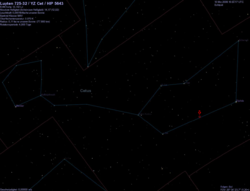
Ross 128 is a red dwarf in the equatorial zodiac constellation of Virgo, near β Virginis. The apparent magnitude of Ross 128 is 11.13, which is too faint to be seen with the unaided eye. Based upon parallax measurements, the distance of this star from Earth is 11.007 light-years, making it the twelfth closest stellar system to the Solar System. It was first cataloged in 1926 by American astronomer Frank Elmore Ross.
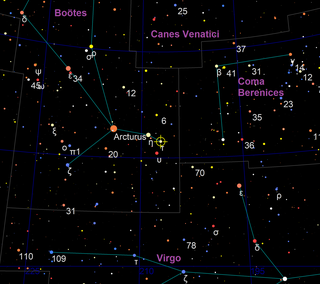
Tau Boötis, Latinised from τ Boötis, is an F-type main-sequence star approximately 51 light-years away in the constellation of Boötes. It is a binary star system, with the secondary star being a red dwarf. In 1999, an extrasolar planet was detected orbiting the primary star. In December 2020, astronomers may have observed, for the first time, radio emissions from a planet beyond the Solar System. According to the researchers: "The signal is from the Tau Boötis system, which contains a binary star and an exoplanet. We make the case for an emission by the planet itself."
Gliese 65, also known as Luyten 726-8, is a binary star system that is one of Earth's nearest neighbors, at 8.8 light-years from Earth in the constellation Cetus. The two component stars are both flare stars with the variable star designations BL Ceti and UV Ceti.

Gliese 876 is a red dwarf star 15.2 light-years away from Earth in the constellation of Aquarius. It is one of the closest known stars to the Sun confirmed to possess a planetary system with more than two planets, after GJ 1061, YZ Ceti, Tau Ceti, and Wolf 1061; as of 2018, four extrasolar planets have been found to orbit the star. The planetary system is also notable for the orbital properties of its planets. It is the only known system of orbital companions to exhibit a near-triple conjunction in the rare phenomenon of Laplace resonance. It is also the first extrasolar system around a normal star with measured coplanarity. While planets b and c are located in the system's habitable zone, they are giant planets believed to be analogous to Jupiter.
79 Ceti, also known as HD 16141, is a binary star system located 123 light-years from the Sun in the southern constellation of Cetus. It has an apparent visual magnitude of +6.83, which puts it below the normal limit for visibility with the average naked eye. The star is drifting closer to the Earth with a heliocentric radial velocity of −51 km/s.
HD 179949 is a 6th magnitude star in the constellation of Sagittarius. It is a yellow-white dwarf, a type of star hotter and more luminous than the Sun. The star is located about 90 light years from Earth and might be visible under exceptionally good conditions to an experienced observer without technical aid; usually binoculars are needed.
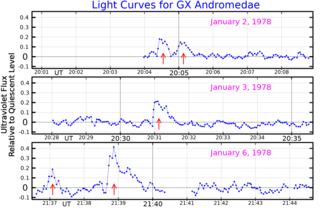
Groombridge 34 is a binary star system in the northern constellation of Andromeda. It was listed as entry number 34 in A Catalogue of Circumpolar Stars, published posthumously in 1838 by British astronomer Stephen Groombridge. Based upon parallax measurements taken by the Gaia spacecraft, the system is located about 11.6 light-years from the Sun. This positions the pair among the nearest stars to the Solar System.

AD Leonis (Gliese 388) is a red dwarf star. It is located relatively near the Sun, at a distance of 16.2 light-years, in the constellation Leo. AD Leonis is a main sequence star with a spectral classification of M3.5V. It is a flare star that undergoes random increases in luminosity.
94 Ceti is a trinary star system approximately 73 light-years away in the constellation Cetus.
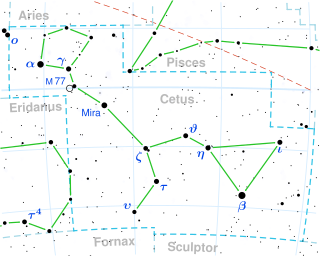
Kappa1 Ceti, Latinized from κ1 Ceti, is a variable yellow dwarf star approximately 30 light-years away in the equatorial constellation of Cetus.
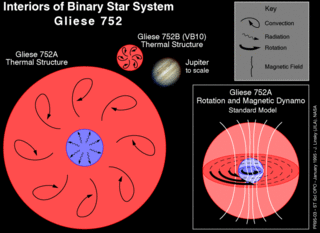
Gliese 752 is a binary star system in the Aquila constellation. This system is relatively nearby, at a distance of 19.3 light-years.

HD 114613 is a fifth magnitude yellow subgiant that lies 66.7 light-years away in the constellation of Centaurus. The star may be host to a long-period giant planet.
EQ Pegasi is a nearby binary system of two red dwarfs. Both components are flare stars, with spectral types of M4Ve and M6Ve respectively, and a current separation between the components of 5.8 arcseconds. The system is at a distance of 20.4 light-years, and is 950 million years old. The primary star is orbited by one known exoplanet.
Gliese 880 is a red dwarf star in the northern constellation of Pegasus that may host an exoplanetary companion. No stellar companions to Gliese 880 have been discovered as of 2020.
GJ 3512 is a nearby star in the northern circumpolar constellation of Ursa Major. It is invisible to the naked eye but can be observed using a telescope, having an apparent visual magnitude of +15.05. The star is located at a distance of 31 light-years from the Sun based on parallax. It has a high proper motion, traversing the celestial sphere at the rate of 1.311″ yr−1. The measurement of the star's radial velocity is poorly constrained, but it appears to be drifting further away at a rate of ~8 km/s.
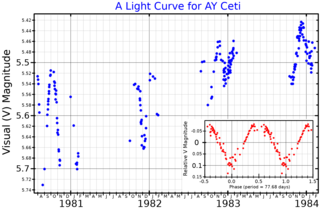
AY Ceti, also known as 39 Ceti, is a star about 244 light years from Earth in the constellation Cetus. It is a 5th magnitude star, making it faintly visible to the naked eye of an observer far from city lights. AY Ceti is an RS Canum Venaticorum variable star, varying in brightness from magnitude 5.35 to 5.58 over a period of about 77 days.
